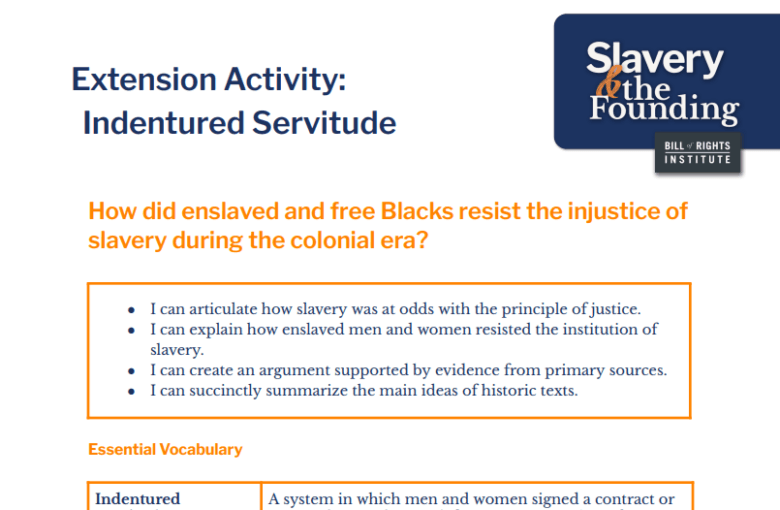Extension Activity: Indentured Servitude
How did enslaved and free Blacks resist the injustice of slavery during the colonial era?
- I can articulate how slavery was at odds with the principle of justice.
- I can explain how enslaved men and women resisted the institution of slavery.
- I can create an argument supported by evidence from primary sources.
- I can succinctly summarize the main ideas of historic texts.
Essential Vocabulary
| Indentured Servitude | A system in which men and women signed a contract or were indentured to work for a certain number of years in return for transportation to the American colonies and food, clothing, and shelter once they arrived. |
| Indenture | The contract signed by an indentured servant and their master as an agreement to provide a certain number of years of labor in return for passage to the American colonies and food, clothing, and shelter once they arrived. |
| Chattel | Personal property |
| Mulatto | A person of mixed African and European descent. |
| Freedom dues | A gift of land and starting materials, such as clothing or seeds, from a master to a former indentured servant after their contract for labor was complete. |
Building Context
Indentured servitude refers to a system in which men and women signed a contract or were indentured to work for a certain number of years in return for transportation to the American colonies and food, clothing, and shelter once they arrived. During the term of service, a master owned the labor of the person as opposed to owning the person like chattel or property. The status of an indentured servant was not inheritable in Virginia, with one distinctive exception: mulatto children born to a white mother were bound to an indenture of 30 years. The intent behind the law was to discourage the mixing of races. After a servant completed their contract, they were given freedom dues which typically took the form of land. This system was practiced in England and was a common option in the settlement of colonial Virginia, which was in constant need of cheap labor. When indentured servants ran away before the end of their contract (also known as indenture or covenant), masters often published classified ads offering rewards for their return. Generally, the advertisements described the person’s physical appearance and any details surrounding their disappearance. They also offered a reward for their return.
Source 1: Sale of Indentured Servants, May 1752
| Staymaker | Person who makes corsets. |
| Mantuamaker | Person who makes women’s clothing. |
https://research.colonialwilliamsburg.org/CWDLImages/VA_GAZET/Images/VG/1752/0079hi.jpg
The Colonial Williamsburg Foundation, www.colonialwilliamsburg.com, column 1
THE Ship Burwell, from Ireland, with Servants, among whom there are several Tradesmen, Farmers, Seamstresses, Staymakers, Mantuamakers, etc. The Sale with be at West-Point on Friday the 15th [Instant], where it will be continued ‘til all are sold by JOHN MARTIN
Comprehension and Analysis Questions
- What was the ship Burwell carrying?
- Where was the ship sailing from?
- What trades did the passengers practice?
- Compare this list with the roles held by enslaved men and women in the warm-up activity. What conclusions can you draw from this? What additional information would you need to support this conclusion?
Source 2: Runaway Indentured Servant Stephen Baillie, 1755
| Contrives | Delivers |
| Pistole | A Spanish gold coin. Colonists were not allowed to coin their own money and usually used foreign coins. In the mid-18th century, a pistole was worth slightly less than one pound. |
https://research.colonialwilliamsburg.org/CWDLImages/VA_GAZET/Images/VG/1755/0102hi.jpg
The Colonial Williamsburg Foundation, www.colonialwilliamsburg.com, Column 1
RAN AWAY the 18th of November, from the Subscriber living in Essex County, an English Servant Boy named Stephen Baillie, about fifteen Years of Age, well grown, about 5 feet six inches high. He is a well looking fellow, and has a sly Cast with his Eyes. He carried away with him a small light gray Horse with a bob Tail … As he has gone by Water several Times he may pretend to be a Sailor. Whoever takes up the said Servant, and contrives him to me, shall have a Pistole Reward besides what the law allows.
Archibald MacCaul
Comprehension and Analysis Questions
- What details does this advertisement reveal about the young man who ran away?
- What does it not reveal?
- What does Archibald MacCaul offer for the capture of his servant?
Source 3: Sam Howel suing for freedom in court, May 2, 1766
| Mulatto | A person of mixed African and European descent. |
https://research.colonialwilliamsburg.org/CWDLImages/VA_GAZET/Images/PD/1766/0036hi.jpg
The Colonial Williamsburg Foundation, www.colonialwilliamsburg.com, page 3 column 2
RUN away from the subscriber, the 20th of October, a likely young Mulatto named SAM HOWEL, 23 years old, about 5 feet 9 inches high … He was bound for 31 years, according to the condition of his mother, who was to serve until that time; his pretence for going away was to get his freedom, though he had a trial in the county court, and was adjudged to serve his full time. I did hear that he applied to the King’s Attorney, and he told him he could not get free until his time was out; As he passes for a free man, I imagine he will endeavor to get on board some vessel … Whoever apprehends the said [slave], and brings him to me in Cumberland county, on James river, shall receive [a reward] WADE NETHERLAND
Comprehension and Analysis Questions
- Why did Sam Howel run away, according to this advertisement?
- What do we know about Sam’s parents from this source?
- What does this advertisement reveal about Sam Howel’s position in society?
- How did Sam Howel challenge his position? How would getting on a boat help his escape?
- What does this reveal about legal protections for indentured servants?



